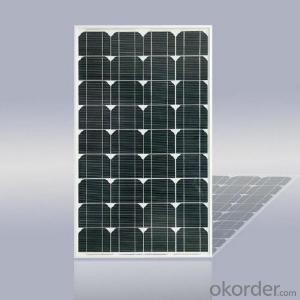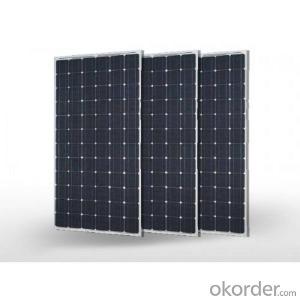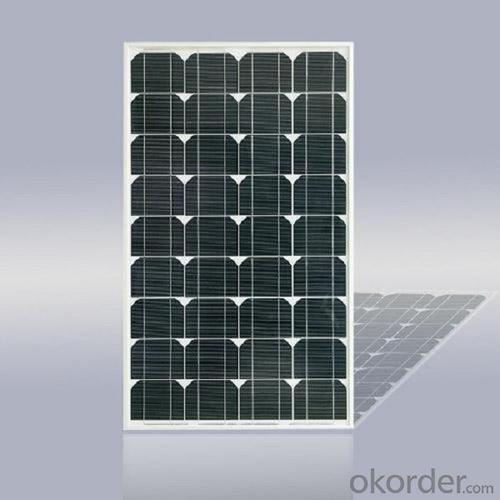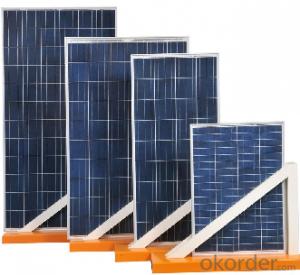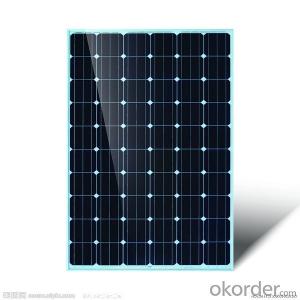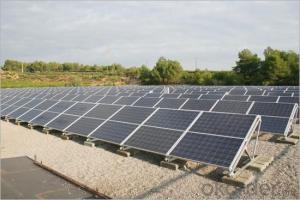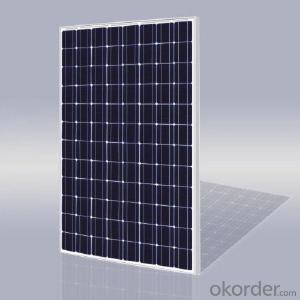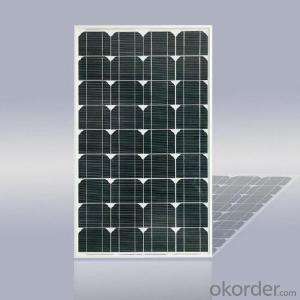Sol Solar Panels 260W - High Efficiency Solar Panels for Sale
- Loading Port:
- Shanghai
- Payment Terms:
- TT OR LC
- Min Order Qty:
- 2600 watt
- Supply Capability:
- 26000 watt/month
OKorder Service Pledge
OKorder Financial Service
You Might Also Like
Specification
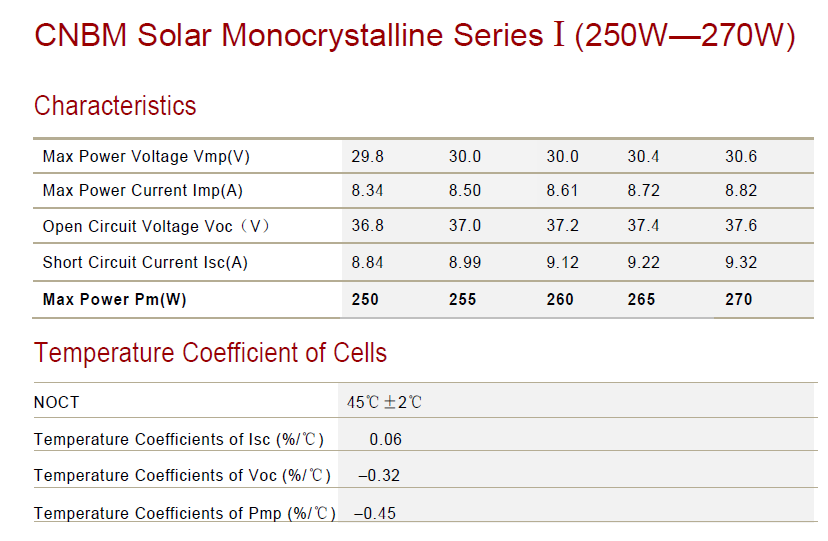
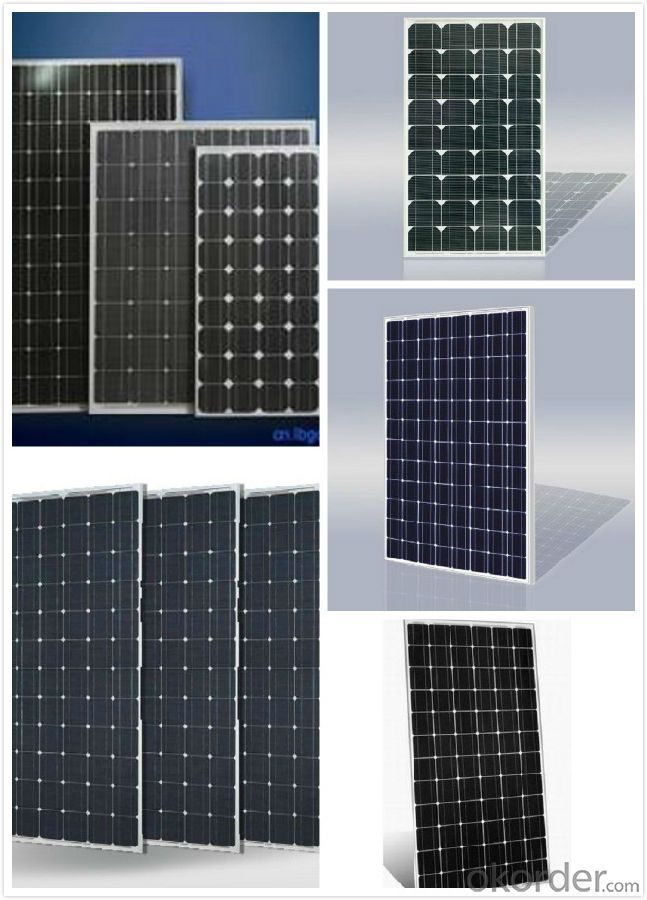
Rated maximum power (Pmax) 260W
Open circuit voltage (vOC) 37.30
Short circuit current (Isc) 8.78
Maximum power voltage (Vmp) 30.10
Maximum power current (Imp) 8.31
Cell efficiency (%) 17.50%
Max system voltage (VDC) 1000V DC
Temperature coefficient of Vm -0.241%/K
Temperature coefficient of Im +0.033%/k
Temperature coefficient of power -0.37%/K
Maximum Series Fuse Rating 15A
Solar cell and configuratiou 60pcs(6*10)in series,156*156mm monocrystalline
Junction box IP65,1000VDC,TUV certified;6 pcs Schottky By-pass diodes
Cable type & CONNECTOR 4m㎡,TUV certificated,0.9m length;MC4
Encapsulation low iron tempered glass,3.2mm thickness,light transmission above 91%;TPT and fast cure EVA
Farame clear anodized aluminum alloy,50/45mm thickness,silver
Dimension (l*W*H) 1640*990*50mm/45mm
Weight 20KG/19KG
Heavy mechanical load salient features 540Pa (ACCORDING TO ICE61215)
Hail impact test lce ball dianeter 25mm,23m/s
Operating temperature -40℃~+85 ℃
Standard test conditions: STC:AM=1.5,1000W/m2,cells temperature 25℃
Power tolerance:±3% (can be provided 0~±3%)
GENERAL INFORMATION
The installation of PV modules requires a great degree of skill and should only be performed by a qualified licensed professional, including licensed contractors and licensed electricians. Please be aware that there is a serious risk of various types of injury occurring during the installation including the risk of electric shock. All CUSTOMER modules are equipped with a permanently attached junction terminal box that will accept variety of wiring applications or with a special cable assembly for ease of installation, and they do not require assembly.
Solar panel working process
In addition to being the ultimate source of all life on earth, the sun is an infinitely renewable, completely pollution-free source of electricity. Instead of burning fossil fuels dug up from the ground in a big power plant – a very 19th century, industrial age approach, when you think about it – solar panels convert sunlight directly into electricity, with no harmful emissions.
The basic unit of a solar panel is a solar cell, which usually consists of one or two layers of silicon-based semiconductor wafers. When struck by the photons in sunlight, the solar cell generates an electrical charge due to the "photovoltaic effect" – which is a pretty good name, since it produces voltage from photons. The flow of these electrons moves in a steady electrical current from one side of the cell to the other.
- Q: Does the new horizons has a solar panel for it power resources instead using nuclear generator?
- No solar panel, and for the reason you stated - it is so far from the Sun that a solar panel would be of little use (and a lot of extra weight) at the distances where the primary part of the mission was being performed. The power source is called an RTG. We can think of it as similar to a nuclear-powered battery or a miniature nuclear power plant. As far as I know it is not intended to reach any other star. If it does, it's power will have long since depleted - and it would take thousands of years at its current speed to reach even the closest star. Closest star: Proxima Centauri, slightly more than 4 light years away. Current speed of New Horizons relative to the Sun: 4.52 km/s That's 0.000048 of the speed of light. It would take more than 20,000 years to reach Proxima Centauri *if* it were heading in that direction (which it is not).
- Q: What is the biggest solar panel you can buy?How much energy can it produce in kwh?Thanks :)
- come to tn
- Q: I would like to know if I had a mobile kitchen could I power it from solar panels mounted atop the vehicle (truck).(to power electric kitchen equipment, i.e. stove, deep fryer.), instead of propane…could I possibly connect the solar panels to a battery to save my generated electricity? If solar panels would not be enough power could a small windmill suffice…?
- The best way to find out is to determine the wattage of each piece of equipment you want to use and how many hours you want to use those pieces of equipment. Finally, calculate the total number of Watt-Hours you need at minimum. Then you need to research solar panels or mobile wind mills (they need to be pretty huge to get a decent amount of energy I think, so solar power is probably the way to go). You will need to figure out the efficiency of the solar panels, the size of the array, how you will turn it or if you will turn it at all (to face the sun to get the maximum energy input, or maybe to use mirrors so you don't have to turn it. Once you find a good configuration for your mobile kitchen, you need to calculate if the Watt-Hours you will generate on an average day (with average weather) is enough to power the equipment whose energy requirements you previously calculated. Then you have to keep in mind that some days will have no sun, and you may not be working on some days, but you can still capture sunlight. For each case, a large battery array will be required. If you had a guage on that array, you could also hook it up to the a small generator in case you need immediate power. It's an eco-friendly process, but the initial cost is high and it requires a lot of research and planning. This is why most people do not do it--not because they don't want free energy from the sun, but because it's not easy to start collecting that energy in an efficient way. Sorry I couldn't give you more specific numbers, but a solar panel sales agency should be able to estimate whether or not you could do it (they'd probably set it all up for you too). ^_^
- Q: I have:4- 5v 200ma solar panels5- 3v ,000ma solar panels- 7amp charge controller- 400watt inverterNow I have all my solar panels linked in series which in theory should give me 35v, 5.8 amps at 203 watts. Is this correct?The main question is, what kind of battery should I get so I can run my miscellaneous electronics off of it?I may not have explained it so well so if you need more information, feel free to ask.
- I okorder and they have deep cycle batteries exclusively made for solar panels. but in theory you should get more than one because it only takes around 4-5 volts to charge the battery and you do not want to have it that high even with a charge controller which i would also recommend getting which is like $50 on OKorder but a charge controller is used so you do not overcharge the batteries and fry them or undercharge the batteries and weaken its life it gets it just perfect. it lets the current go in and when it is charged fully nothing goes in an nothing comes out.... for a inverter the one i was going to get was $70 500 watt inverter but changes it from dc to ac...hope i helped
- Q: Can solar panels be installed on a shaded area?
- Solar panels are most effective when placed in direct sunlight, so installing them in a shaded area would significantly reduce their energy production. However, there are technologies available, such as bifacial solar panels or solar trackers, that can optimize energy generation in partially shaded areas.
- Q: Hello, i want to ask whether if you could make an improvised version of solar panel made from an old CD or DVD?Is it possible or not?Please give me steps on how to make one if you know(put aside the one you see on quot;ehow: How to Make a Solar Panel From CDswhich says a bit confusing for me :( )Why not?
- Cd Solar Panel
- Q: how much do solar panels cost?
- The okorder
- Q: What is the cost of installing solar panels?
- The cost of installing solar panels can vary depending on several factors such as the size of the system, location, type of panels, and any additional equipment or services required. On average, the cost can range from $15,000 to $25,000 for a residential installation. However, it is important to consult with solar installation companies to get accurate quotes tailored to your specific needs.
- Q: Are solar panels worth it?? I mean the price you by for them up front is a lot, so you properly need a loan for it. So how does it work? Won't the loan be just as much as you electric bill?Im just really confused about it.
- If your purchasing solar panels for a building or colony where a few families live together, the cost of the panels can be distributed or shared. And loan and electricity bill wont be the same. Loan is a one time transaction while electricity bill you have to pay monthly and everytime. You dont have to buy solar panels every month lol. So its a better option to spend on solar panels although it maybe a big amount, rather than paying high bills every month....
- Q: Can solar panels be used for powering a data center?
- Yes, solar panels can be used to power a data center. Solar panels generate electricity by converting sunlight into energy, which can be used to power various devices and systems, including data centers. By installing a sufficient number of solar panels and utilizing energy storage systems, a data center can operate on renewable solar power, reducing its reliance on traditional energy sources and minimizing its carbon footprint.
Send your message to us
Sol Solar Panels 260W - High Efficiency Solar Panels for Sale
- Loading Port:
- Shanghai
- Payment Terms:
- TT OR LC
- Min Order Qty:
- 2600 watt
- Supply Capability:
- 26000 watt/month
OKorder Service Pledge
OKorder Financial Service
Similar products
Hot products
Hot Searches
Related keywords
